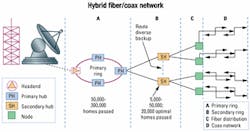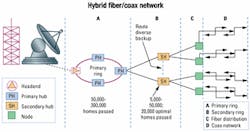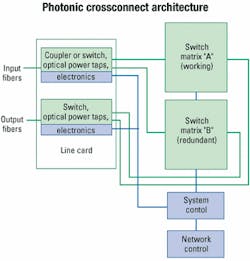Smart optical networks: powered by intelligent optical switches
Optical switching continues to be at the core of optical intelligence, as switching engines have historically been in most network designs.
BY JOHN CLARK
Even the best performance from a standalone optical-switching engine is not enough to satisfy today's evolving optical markets. Optical systems designers need optical-switching platforms that integrate additional functions previously preformed by separate components. These additional functions can also be switched and tuned with the intelligence on-board a true intelligent optical switch.
Leading optical-switching companies have extended their skills toward incorporating specific original equipment manufacturing (OEM) optical design requirements or creating a flexible development platform allowing the designers to change parameters as needed, without requiring hard reconfigurations from the optical-switch supplier. This software control speeds the design process. A turnkey optical package, which eliminates unnecessary splices, adds other OEM components, as needed, in a more efficient design and improves optical control and intelligence. The reduced overall size following this integration is a valuable bonus beyond the intelligence of a smart network system.
Ultra-low-loss tuning is a critical factor for smart networks. Ultra-low loss avoids unneeded, costly amplification stages, while optimizing other loss-inducing optical performance factors in these smart optical networks. A standalone switch could never accomplish that goal. It would appear just like another commodity resistor or diode in the overall scheme of production.
By merging a high-performance, ultra-low-loss optical switch with on-board software intelligence and features such as inherent signal leveling or variable optical attenuation, the switch can compensate for the quality of other devices or the environmental variations seen in other less intelligent components in the integrated system. The incorporation of optical performance monitors and ultra-low-loss software-controlled switches makes smart optical networks possible.
Smart network protection is an architecture that integrates performance monitoring into the switch to ensure rapid awareness of signal degradation and an automatic switchover to backup fiber facilities. Basic performance monitoring includes power sensing, but more sophisticated smart network protection also reports optical signal-to-noise ratio (OSNR) and other performance threshold conditions to simple network-management protocol and other control systems.
Since the switch is in the critical active path and can take action to restore service, smart network protection is critical for emerging optical-network designs. Now that ultra-low-loss 0.3-dB switches are available at low cost and with smart network protection incorporating optical intelligence, prior concerns about the added optical loss of optical switching are gone. Even 2-dB two-stage NxN optical switches are appearing for large applications.
Quality-of-service (QoS) standards have established new quality levels critical for voice and data services. These changing requirements place competitive pressure on legacy telecommunications networks, but can be designed into emerging hybrid fiber/coax (HFC), fiber-to-the-curb (FTTC), and fiber-to-the-home (FTTH) all-optical architectures. In business applications, several major carriers have QoS guarantees with revenue rebates, if each 15-minute service interval is not delivered according to established QoS customer standards. To deliver this level of performance, smart optical-network protection provisioning is becoming mandatory.
In addition to QoS guarantees, 10-day-or-less optical service provisioning guarantees are also becoming the standard for business broadband services. The ability to physically provision access fibers using optical switching allows rapid deployment and early revenue generation to meet rising customer demand.As a bonus, using smart network protection switches, especially with FTTC, FTTH, and passive optical networks, service piracy can be eliminated at the physical level instead of depending on data signals from headends or field-located routers to set-top boxes-historically not tamper-proof. Smart network protection switches function as addressable taps to remotely activate and deactivate different ports individually. The revenue-generating feature of the smart switch is its ability to convert nonpaying customers into paying ones. According to a recent study by a major operator, 7% of all cable customers are unauthorized-but once discovered, about half of those become paying subscribers.
By extending fiber closer to the business (FTTB) and home, distributed routers in "difficult to maintain" field locations can be centralized. Cost-of-ownership savings can be realized for maintenance, in addition to first-cost savings in deploying larger, more cost-efficient routers. Network operators can realize considerable savings per household by introducing intelligent optical transport into their networks.
The HFC network shown in Figure 1 has many segments that can dramatically benefit from a smart protection switching architecture. Segments A, B, and C carry heavy primary and secondary broadband loads that need extra levels of diversity and backup protection, as network traffic continues to expand over the years. As segment D converts from coaxial distribution to fiber, it becomes clear that even FTTB and FTTH will need this level of protection to ensure carrier-grade service reliability.
Each segment of the optical network needs a backup fiber to allow smart switches to self-actuate when necessary or to be externally activated when more marginal performance degradation occurs, allowing an external intelligence system to read the status of various optical nodes before making corrective changes in the network. The backup fiber, represented as the FTTH segment D, has a test frequency generated from a low-power non-DWDM laser to measure the spare fiber's continuity and ability to accept live bandwidth traffic. The same power monitor that is integrated into the switch to measure the active path's power levels can also sample the segment's health status.More sophisticated versions will be deployed to measure other network health factors in the active path, such as bit-error rate (BER) and OSNR. A history of these measurements can then be used to validate the QoS delivered to businesses in support of service guarantees. These smart network protection switches can improve the reliability of current and future network designs. Given the increasing complexity of broadband networks, network operators require monitoring and management capabilities that enable them to view network degradation before it becomes service-affecting.
All networks historically go through several rearrangements over the life of their copper or fiber plant. Sections or segments get redistributed to meet changing demands and architectures over the long life of buried plant. By simply installing a smart cutover optical switch at each end of a fiber route section, future service disruptions can be nearly eliminated. In the past, copper could be easily tapped and rerouted, but now fiber's security becomes a problem when reconfiguring networks unless an ultra-low-loss switch is designed into new networks or added during scheduled maintenance routines. Before reliable 0.3-dB optical switches were available, this application was not feasible in tight optical loss budgets.
Protection switching is a fundamental requirement in optical networks. To achieve reliability and uptime requirements, networks must reconfigure themselves as quickly as possible (the SONET network specifies a recovery time of no more than 50 msec) in the event of a fiber or equipment failure. Optical switches have long been used at both ends of a fiber-optic transmission cable to switch from an active to a backup path. Today, networks are migrating from a mixture of optical and electrical elements to all-optical, and new protection switching requirements have emerged.
As optical, or photonic, networks become a reality, new protection switching architectures can add value for systems designers by offering significant reductions in size and power. A common architecture for a photonic crossconnect is shown in Figure 2. Typically, there are dual redundant switch fabrics to perform the crossconnect function, and they interface to the rest of the network through line cards that contain both optical and electronic components.
The line cards perform several important functions, one of which is protection switching. As opposed to protecting fiber runs between pieces of equipment in the network, these switches protect against failures inside the equipment, such as the failure of all or some of the primary switch fabric. While OEMs have different architectures, according to their customers' requirements, all use optical switches.
Optical intelligence also enables a host of less conventional applications that lead to improved optical-component integration and system management and control. The designer's fear of using optical switches with 6- to 13-dB loss is gone. Now that more useful levels of loss are available, automation of component insertion and control at several stages can be implemented within allowed loss budgets.
In configurations similar to Figure 3, optical performance monitors can be used to determine the need for inserting various levels of attenuation with variable optical attenuators and dispersion compensation modules. Many other optical management devices can be switched into the system, as channels change or reconfigurations become necessary over the life of the system and optical route.Even certain ultra-low-loss optical switches will perform more practical variable optical attentuation within the smart switch. With loss starting at a low 2 dB per switched channel, signals will less likely require costly amplification. Combining smart variable optical attentuation within an ultra-low-loss switch further integrates network functionality and reduces overall system size.
Simulating a discrete optical IC in functionality, a series of ultra-low-loss switches coupled with the optical intelligence of a closed-loop system, can automate, design, and perform the function of a designer's toolkit throughout the system's life as factors or components change.
As true solid-state ultra-low-loss switching designs become available over the next three years, the size density of these optically switched network configurations, or optical ICs, will dramatically shrink. Again, ultra-low loss is the critical factor for the application to cost-effectively perform. The size reduction is just the bonus. In later years, these optically managed ICs can potentially allow designs to become the size of a fiber cross section.
Significant improvements have recently been made in producing reliable, ultra-low-loss smart optical switches. That presents several major application opportunities for network operators to reduce costs and enhance revenues by:
- Centralizing distribution from "hard to service" field node locations.
- Deploying smart-switch QoS physical optical layer monitoring, provisioning, and control.
- Introducing smart cutover switches at each end of fiber sections as insurance for the inevitable need to reroute or reconfigure spans over the life of the fiber plant.
Smart optical networks are becoming integrated within modules and subsystems in today's stage of evolution, but these modules will soon become integrated in the space of a sugar cube. Optical switching continues to be at the core of optical intelligence, as switching engines have historically been in most all network designs.
John Clark is vice president of business development at eMarket Velocity Inc. (McKinney, TX). He can be reached via e-mail at [email protected].



